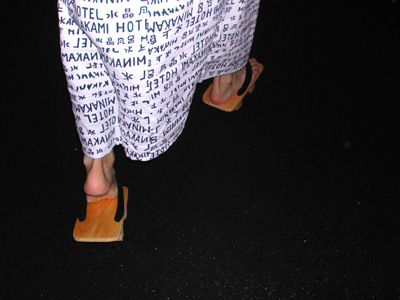Traditional Japanese Footwear A New Way of Walking
Traditional Japanese Footwear: Karan koron, karan koron, this is the Japanese sound of someone walking down the street in geta, or traditional wooden clogs.
Traditional Japanese Footwear
Karan koron, karan koron, this is the Japanese sound of someone walking down the street in geta, or traditional wooden clogs. For the Japanese this is a nostalgic sound, that conjures up images of people wearing yukata (informal cotton kimono) and enjoying the relaxed ambience of night-time summer festivals.
Footwear plays an interesting role in daily Japanese life as a way of marking the transition between different kinds of interior and exterior spaces. For example, before entering a house, outside shoes are removed in the genkan. After stepping into the interior family space, inside slippers are put on. And before using the rest room one takes off the inside house slippers and puts on a special pair of "bathroom slippers". One classic error of foreign guests is to forget to change back to the regular slippers after leaving the rest room. This situation, of wearing the bathroom slippers into other rooms, represents bringing something unclean into a clean area and provokes either laughter or disgust, depending on the host family. So strong are the divisions between spaces, articulated by changes in footwear, that if a person leaves the house in a hurry, laces up their shoes, and then remembers a forgotten item, rather than step on the interior floor in their outside shoes they will crawl on their hands and knees, with their feet held up high to retrieve the forgotten item.
Nor are these delineations limited to personal space. An American journalist, giving birth to a baby in Tokyo, was issued a pair of slippers when she was admitted to the hospital in labor, and was required to change to slippers of another color when she entered the delivery room. Special shoes for specific situations are also part of the cultural picture. While I was living in a mountain village, I watched a bride dressed in a wedding kimono and wearing very high wedge sandals bid a formal farewell to her neighbors. When she finished she walked away slowly, assisted by a woman on each arm. A crowd of village woman walked behind her. "When you got married, was it like this?" I asked one of them. "Oh, yes, just like this I needed help to walk. Oh those shoes!"
Walking through the Gion entertainment area in Kyoto you may catch a glimpse of a geisha. Take a look at her feet. If she is wearing very high clogs, she is an apprentice geisha or maiko. This custom dates from the period when apprentices were children, and wore tall shoes to add to their height. Nowadays, maiko are young women, who walk gracefully and unassisted in high clogs.
Shoes are also connected to Japanese beliefs about health. Older people have pointed out to me that walking in geta or backless sandals requires the wearer to flex the foot with each step just to keep the footwear from falling off. This repeated flexing is thought to contribute to good health, and some believe that wearing Western shoes (which do not require this muscular movement) is less healthy. A contemporary approach to the health and footwear issue can be seen in slippers featuring inside soles covered with beige plastic nodules. Positioned to stimulate health-promoting pressure points, the nodules produce sensory stimulation to mild pain, depending on the wearer. Buying traditional Japanese footwear: These shops sell geta for about ¥2,000: Kyoto Handicraft Center, Tel: 075 761 7000. Nakatsuji, Tel: 075 492 0436. Oshima in Nishiki market, Tel: 075 221 3473. For wooden sandals with indigo fabric trim (from about ¥3,000): Yamato Mingeiten, Tel: 075 221 2641. Written by Anne Overton and edited by Ian Ropke, founder and owner of Your Japan Private Tours: personalized quality private travel services all over Japan since 1992. To learn more, visit our site (www.kyoto-tokyo-private-tours.com) or call us on +1-415-230-0579.











